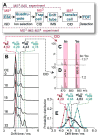Gas-phase ion isomer analysis reveals the mechanism of peptide sequence scrambling
- PMID: 24313304
- PMCID: PMC4005837
- DOI: 10.1021/ac401578p
Gas-phase ion isomer analysis reveals the mechanism of peptide sequence scrambling
Abstract
Peptide sequence scrambling during mass spectrometry-based gas-phase fragmentation analysis causes misidentification of peptides and proteins. Thus, there is a need to develop an efficient approach to probing the gas-phase fragment ion isomers related to sequence scrambling and the underlying fragmentation mechanism, which will facilitate the development of bioinformatics algorithm for proteomics research. Herein, we report on the first use of electron transfer dissociation (ETD)-produced diagnostic fragment ions to probe the components of gas-phase peptide fragment ion isomers. In combination with ion mobility spectrometry (IMS) and formaldehyde labeling, this novel strategy enables qualitative and quantitative analysis of b-type fragment ion isomers. ETD fragmentation produced diagnostic fragment ions indicative of the precursor ion isomer components, and subsequent IMS analysis of b ion isomers provided their quantitative and structural information. The isomer components of three representative b ions (b9, b10, and b33 from three different peptides) were accurately profiled by this method. IMS analysis of the b9 ion isomers exhibited dynamic conversion among these structures. Furthermore, molecular dynamics simulation predicted theoretical drift time values, which were in good agreement with experimentally measured values. Our results strongly support the mechanism of peptide sequence scrambling via b ion cyclization, and provide the first experimental evidence to support that the conversion from molecular precursor ion to cyclic b ion (M → (c)b) pathway is less energetically (or kinetically) favored.
Conflict of interest statement
The authors declare no competing financial interest.
Figures




Similar articles
-
Sequence-scrambling fragmentation pathways of protonated peptides.J Am Chem Soc. 2008 Dec 31;130(52):17774-89. doi: 10.1021/ja805074d. J Am Chem Soc. 2008. PMID: 19055406
-
H/D exchange kinetics: experimental evidence for formation of different b fragment ion conformers/isomers during the gas-phase peptide sequencing.J Am Soc Mass Spectrom. 2010 Mar;21(3):358-69. doi: 10.1016/j.jasms.2009.10.017. Epub 2009 Oct 29. J Am Soc Mass Spectrom. 2010. PMID: 20005740
-
Loss of ammonia during electron-transfer dissociation of deuterated peptides as an inherent gauge of gas-phase hydrogen scrambling.Anal Chem. 2010 Dec 1;82(23):9755-62. doi: 10.1021/ac101889b. Epub 2010 Oct 29. Anal Chem. 2010. PMID: 21033729
-
Measuring the hydrogen/deuterium exchange of proteins at high spatial resolution by mass spectrometry: overcoming gas-phase hydrogen/deuterium scrambling.Acc Chem Res. 2014 Oct 21;47(10):3018-27. doi: 10.1021/ar500194w. Epub 2014 Aug 29. Acc Chem Res. 2014. PMID: 25171396 Review.
-
Peptide fragmentation products in mass spectrometry probed by infrared spectroscopy.Top Curr Chem. 2015;364:153-81. doi: 10.1007/128_2014_576. Top Curr Chem. 2015. PMID: 25370523 Review.
Cited by
-
Mass Spectrometry Approaches Empowering Neuropeptide Discovery and Therapeutics.Pharmacol Rev. 2022 Jul;74(3):662-679. doi: 10.1124/pharmrev.121.000423. Pharmacol Rev. 2022. PMID: 35710134 Free PMC article. Review.
-
The role of the mobile proton in fucose migration.Anal Bioanal Chem. 2019 Jul;411(19):4637-4645. doi: 10.1007/s00216-019-01657-w. Epub 2019 Mar 2. Anal Bioanal Chem. 2019. PMID: 30826852 Free PMC article.
-
Composite Multidimensional Ion Mobility-Mass Spectrometry for Improved Differentiation of Stereochemical Modifications.Anal Chem. 2023 Jan 31;95(4):2221-2228. doi: 10.1021/acs.analchem.2c03522. Epub 2023 Jan 12. Anal Chem. 2023. PMID: 36635260 Free PMC article.
-
Advances in Mass Spectrometric Tools for Probing Neuropeptides.Annu Rev Anal Chem (Palo Alto Calif). 2015;8:485-509. doi: 10.1146/annurev-anchem-071114-040210. Epub 2015 Jun 11. Annu Rev Anal Chem (Palo Alto Calif). 2015. PMID: 26070718 Free PMC article. Review.
-
Considerations for defining +80 Da mass shifts in mass spectrometry-based proteomics: phosphorylation and beyond.Chem Commun (Camb). 2023 Sep 26;59(77):11484-11499. doi: 10.1039/d3cc02909c. Chem Commun (Camb). 2023. PMID: 37681662 Free PMC article. Review.
References
-
- Aebersold R, Mann M. Nature. 2003;422:198–207. - PubMed
-
- Wysocki VH, Resing KA, Zhang Q, Cheng G. Methods. 2005;35:211–222. - PubMed
-
- Harrison AG, Young AB, Bleiholder C, Suhai S, Paizs B. J Am Chem Soc. 2006;128:10364–10365. - PubMed
-
- Yague J, Paradela A, Ramos M, Ogueta S, Marina A, Barahona F, Lopez de Castro JA, Vazquez J. Anal Chem. 2003;75:1524–1535. - PubMed
Publication types
MeSH terms
Substances
Grants and funding
LinkOut - more resources
Full Text Sources
Other Literature Sources

